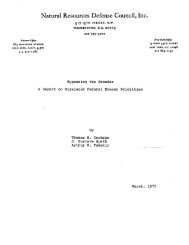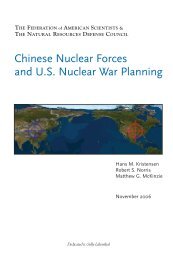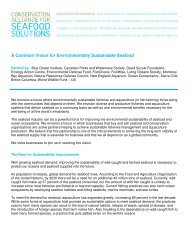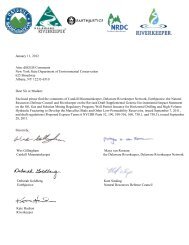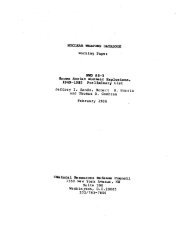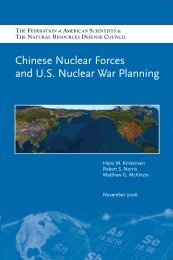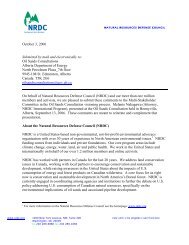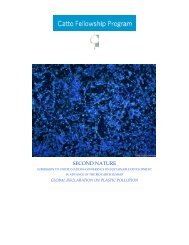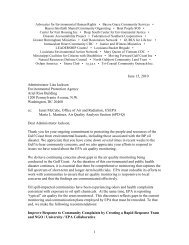Natural Resources Defense Council, Inc. - NRDC Document Bank ...
Natural Resources Defense Council, Inc. - NRDC Document Bank ...
Natural Resources Defense Council, Inc. - NRDC Document Bank ...
Create successful ePaper yourself
Turn your PDF publications into a flip-book with our unique Google optimized e-Paper software.
BOARD OF TRUSTEES<br />
Stephen P. Duggan<br />
Chairman<br />
James Marshall<br />
rice Chairman<br />
Dr. George M. Woodwell<br />
rice Chairman<br />
Dr. Dean E. Abrahamson<br />
Mn. Louis Auchincloss<br />
Boris I. Biuker<br />
Frederick A. Collins, Jr.<br />
Dr. Rene J. Dubos<br />
James n. Frankel<br />
Robert W. Gilmore<br />
Lady Jackson, D.n.£.<br />
Hamilton Kean<br />
Dr. Joshua Lcderberg<br />
Anthony ~lazloccbi<br />
Paul N. McCloskey, Jr.<br />
Michael Mcintosh<br />
Eleanor Holmes Norton<br />
Owen OIpin<br />
Franklin E. Parker<br />
Dr. Gifford B. Pinchot<br />
Charles B. Rangel<br />
Robert Redford<br />
Jobn R. Robinson<br />
Laurance Rockefeller<br />
J. Willard Roosevelt<br />
Whitney North Seymour. Jr.<br />
David Sive<br />
Beatrice Abboll Duggan<br />
U.N. Representative<br />
John H. Adams<br />
Executive Director<br />
~73<br />
100% Recycled Paper<br />
<strong>Natural</strong> <strong>Resources</strong> <strong>Defense</strong> <strong>Council</strong>, <strong>Inc</strong>.<br />
917 15TH STREET, N.W.<br />
WASHINGTON, D.C. 20005<br />
202 737-5000 .<br />
<strong>NRDC</strong> STATEl'1ENT<br />
BEFORE THE<br />
SUBCO~~ITTEE ON ENERGY AND THE ENVIRONMENT<br />
OF THE<br />
CO~ITTEE ON INTERIOR AND INSULAR AFFAIRS<br />
U.S. HOUSE OF REPRESENTATIVES<br />
FEBRUARY 27, 1976<br />
WITNESSES:<br />
ARTHUR R. TAMPLIN<br />
THOMAS B. COCHRAN<br />
Dr. Arthur Tamplin is a bio-physicist formerly<br />
with the AEC's Lawrence Radiation Laboratory<br />
and co-author of Poisoned Power: The Case<br />
Against Nuclear Power Plants.<br />
Dr. Thomas Cochran is a nuclear physicist and<br />
the author of The Liquid Metal Fast Breeder<br />
Reactor: An Environnental and Economic Critique.<br />
Both are membe rs of the staff of the \'lashington,<br />
D.C. office Qf the <strong>Natural</strong> <strong>Resources</strong> <strong>Defense</strong><br />
<strong>Council</strong>.<br />
New YOl"k Office<br />
15 WEST 44TH STREET<br />
NEW Y0Il-K, N.Y. ]0036<br />
212 869-015°<br />
TVestern Office<br />
664 HAMILTON AVENUE<br />
PALO ALTO, CALIF. 94301<br />
415 327-1080
<strong>NRDC</strong> STATEMENT<br />
BEFORE THE<br />
SUBCOMMITTEE ON ENERGY AND THE ENVIRONMENT<br />
OF THE<br />
COMMITTEE ON INTERIOR AND INSULAR AFFAIRS<br />
U.S. HOUSE OF REPRESENTATIVES<br />
February 27, 1976<br />
Arthur R. Tamplin<br />
Thomas B. Cochran<br />
We were requested to present an overview of safeguards<br />
as applied to the domestic nuclear industry. We shall make two<br />
points in this presentation:<br />
1. Existing domestic safeguards are totally inadequate.<br />
We believe that the situation existing today is critical and<br />
have petitioned the NRC to take far-reaching action immediately.<br />
2. The development of an adequate system of domestic safe-<br />
guards for a large civilian plutonium industry will most likely<br />
prove to be an impossibility. Moreover, in trying to develop and<br />
sustain such a safeguards system we will be forced to accept<br />
major alterations in our open society and its institutions. We<br />
have grave doubt that a plutonium fueled economy is compatible<br />
with civil liberties as we know them today.<br />
During 1973 and 1974 a number of reports were published that<br />
were highly critical of existing domestic safeguards. Prominent
-2-<br />
among these were two GAO reports, the report 'of the FOrd Energy<br />
Policy Project by Willrich and Taylor, and the AEC's Special<br />
Safeguards Study known as the Rosenbaum Report. '1-4/<br />
Prodded by these reports the AEC modified its safeguard<br />
regulations in 1974. However, the Rosenbaum Report, published<br />
after the regulations were changed, concluded with the following:<br />
"Even though safeguard regulations have just been<br />
revised and strengthened, we feel that [the] new<br />
regulations are inadequate and that immediate steps<br />
should be taken to greatly strengthen the protection<br />
of special nuclear materials. We hope that this<br />
paper will contribute in a positive way to the<br />
speedy implementation of such steps."<br />
In an expression of its concern, the u.S. Congress, in the<br />
Energy Reorganization Act of 1974, mandated that the newly<br />
created Nuclear Regulatory Commission undertake a one year study<br />
of safeguards. This study, called the Security Agency Study,<br />
is nearing completion.<br />
!/ u.S. General Accounting Office, Improvements Needed in the<br />
Program for the Protection of Special Nuclear Material (November 7,<br />
1973)<br />
~/ U.S. General Accounting Office, Protecting Special Nuclear<br />
Material in Transit: Improvements Made and Existing Problems<br />
(April 12, 1974)<br />
~/ Willrich and Taylor, Nuclear Theft: Risks and Safeguards<br />
(1974)<br />
!/ U.s. Atomic Energy Commission, Special Safeguards Study<br />
("Rosenbaum Report") (April 29, 1974)
-3-<br />
Late last year, after undergoing classification review,<br />
.the reports of numerous NRC safeguards consultants were made<br />
,public. These reports were critical of existing domestic safe-<br />
guards and have served to heighten our concern over existing<br />
'domestic safeguards. These reports and other information have<br />
convinced us that the possibility that plutonium or other similar<br />
materials now held by companies under NRC licenses might be stolen<br />
and fabricated into a nuclear bomb is real. Terrorist activity and<br />
other forms of anti-social violence are an almost daily occurrence.<br />
In an age of organized crime, of terrorists bombings, the risks<br />
of nuclear theft, blackmail and terrorism cannot be dismissed.<br />
From 1969 through 1975 there were 99 reported threats and acts of<br />
violence directed against licensed nuclear facilities in the<br />
U.S., ~ 76 threats and acts of violence directed against unli-<br />
censed nuclear facilities, and 28 threats and acts of violence<br />
. Lvi 1 . '1 6/<br />
~nvo v1ng nuc ear mater1a s. -<br />
The present situation is dangerous and requires urgent action<br />
by the Commission. Numerous private facilities around the country<br />
~ Letter to James M. Cubie, Public Citizen, dated January 19,<br />
1976, from John G. Davis, u.s. Nuclear Regulatory Commission.<br />
6/ Letter to James M. Cubie, Public Citizen, dated January 26,<br />
from H.E. Lyon, U.S. Energy Research and Development Administration.
-4-<br />
are licensed to, and do, possess and s~ip plutonium and other<br />
nuclear bomb materials. This material can be stolen and<br />
fabricated into a nuclear weapon with skills and equipment<br />
which can be bought. find the incentive to resort to nuclear<br />
violence appears to exist.<br />
In late January of this year, we 'obtained two internal NRC<br />
documents. The material in these documents precipitated our<br />
decision to petition the NRC for emergency safeguards action.<br />
One document is a memorandum which reveals that at least some<br />
members of the NRC staff are deeply concerned that nuclear bomb<br />
materials now held by private companies under NRC licenses may<br />
not be adequately protected from theft. A second document, a<br />
preliminary version of the Executive Summary of the NRC's<br />
Security Agency Study, suggests additional reasons for concern<br />
that plutonium and highly enriched uranium in circulation today<br />
might be stolen. We would like to submit both of these docu-<br />
ments for the record.<br />
In the memorandum, dated January 19, 1976, Carl H. Builder,<br />
Director of the NRC's Division of Dafeguards, concedes that he is<br />
"not in a position to judge current safeguards [against nuclear<br />
theft] as adequate or inadequate." The Builder memorandum goes<br />
much further, however. It states:
-5-<br />
"I am concerned that some or even many of our currently<br />
licensed facilities may not have safeguards which<br />
are adequate against the lowest levels of design threat<br />
we are considering in GESMO" (which are "for an internal<br />
[employee] threat, one person and, for an external<br />
threat, three persons").<br />
In short, the head of the NRC's safeguards program is stating<br />
that he doubts that the safeguards employed at some or even many<br />
licensed facilities are adequate to prevent plutonium or similar<br />
materials from being stolen even when only small efforts are in-<br />
volved, such as a theft attempt by one employee or three armed<br />
intruders. This small threat of 1 to 3 individuals must be<br />
compared with the credible threat or more prudently the maximum<br />
credible threat. These threats are discussed in the other NRC<br />
document, the Draft Executive Summary of the Security Agency<br />
Study:<br />
"Congressional concern for adequate safeguards was<br />
heightened as a result of a special safeguards study<br />
done for the Atomic Energy Commission in 1974. That<br />
study, by David Rosenbaum and others, ... expressed<br />
concern about the adequacy of protection afforded SNM<br />
by the private industrial security systems of licensees.<br />
One aspect of concern was the level of threat<br />
to facilities and SNM. The authors postulated a maximum<br />
credible threat consisting of 15 highly trained<br />
men, three of whom might be "insiders", employed by<br />
the licensee target firm.<br />
* * *<br />
"To estimate the credible threat, the office of<br />
Nuclear Materials Safety and Safeguards researched<br />
19 relevant studies and conducted 9 interviews with
-6-<br />
individuals and groups of professional analysts from<br />
the FBI, the intelligence community, the Department<br />
of <strong>Defense</strong> and State and local law enforcement agencies.<br />
"What emerged from this was a consensus estimate<br />
that an external threat group will probably number<br />
about 6-8 persons and very likely not exceed 12 persons.<br />
"[A] credible internal threat, for safeguards purposes,<br />
is estimated to consist of 2-3 persons in collusion."<br />
Given threats of this size, it must be seriously questioned whether<br />
any of the facilities which are licensed to possess and transport<br />
plutonium and highly enriched uranium are adequately safeguarded.<br />
Present regulations require two guards armed with pistols. These<br />
two guards could be confronted by 6 to 15 commandoes armed with<br />
automatic weapons, grenades and bazookas. Moreover, one or both<br />
of the guards could be part of the attacking force.<br />
Besides inadequate numbers of guards relative to the threat,<br />
the Executive Summary of the Security Agency Study and the various<br />
consultant reports point out other serious problems. For example,<br />
one of the consultant reports, that of the u.S. Marshals Service, ,<br />
begins with this statement: 7/<br />
"'The image of security is all that's wanted. I<br />
This quotation from a study entitled Private<br />
Security and the Public Interest effectively illustrates<br />
one problem with guard forces employed<br />
by the private sector of the nuclear industry<br />
throughout the United States: too often the image<br />
has little substance behind it."<br />
2/ u.s. Marshals Service, Security of Special Nuclear Materials<br />
(October, 1975).
-7-<br />
We conclude that this is no idle statement, because the<br />
Marshals' report also states:<br />
"[TJhe writers of this report have only considered<br />
private guards in nuclear facilities. The generalizations<br />
are based upon research, extensive discussions<br />
with private security executives and<br />
actual on-site observation of guards at s~lected<br />
nuclear facilities."<br />
Another consultant, Mr. Charles Brennan, former Assistant Director<br />
of the FBI for Domestic Intelligence, recently stated: ~/<br />
"The safeguards are a joke. The companies<br />
involved are interested mostly in saving money.<br />
They're doing only the bare minimum of security<br />
required by the Nuclear Regulatory Commission. II<br />
These conclusions by Brennan and the U.S. Marshals are borne<br />
out by the revelation this week 9/ that the workers handling bomb-<br />
grade uranium in a plant in Erwin, Tennessee, worked under an<br />
"honor system", and were not searched when leaving the working<br />
areas where the uranium was kept.<br />
~ U.S. News and World Report, February 16, 1976, p. 50.<br />
~/ John F. Fialka, Washington star, February 24, 1976, p. 1.<br />
Based on a report by Barbara Ne~man, National Public Radio.
-8-<br />
Among other problems identified in the .Executive Summary and<br />
consultant reports are the following:<br />
1. recruiting, clearing, training and<br />
equipping sufficient guard personnel;<br />
2. acquiring the necessary legal authority<br />
to permit guards to obtain the necessary<br />
weapons and to transport them across<br />
state lines;<br />
3. acquiring the necessary legal authority<br />
to permit guards to use force or deadly<br />
force in their duties (such authority<br />
could be justified only if guards were<br />
well-qualified and trained);<br />
4. establishing adequate communications<br />
and other protective systems during the<br />
phase of transportation of special nuclear<br />
materials; and<br />
5. establishing reaction forces capable<br />
of responding quickly with adequate<br />
assistance during an atteMpted theft.<br />
Obviously, these and other problems cannot be solved<br />
quickly or easily. And this is why we have urged the NRC to' con-<br />
sider such measures as making the securi.ty of the nuclear bomb<br />
material in presently licensed facilities the responsibility of<br />
the u.s. Marshals Service and halting all transportation of this<br />
material except that essential for national defense.<br />
Subsequent to filing our petition, we requested and were<br />
granted on February 13 a meeting with the NRC safeguards staff.<br />
This meeting was open to the public. Shortly thereafter we were
equested by the NRC staff not to release the transcripts of<br />
that meeting because the staff felt that a discussion of<br />
evaluation criteria, used by the staff to determine whether<br />
safeguards were adequate, should not be made public. However,<br />
before we had an opportunity to make a response to the request,<br />
the Commission determined, independently, that NRC would re-<br />
lease the transcripts. These transcripts reveal that the situation<br />
is actually worse then the Builder memorandum suggested. We<br />
would like to submit pages 48 - 64 of this transcript for the<br />
record.<br />
The transcript, on pages 48-50, discloses, contrary to the<br />
consultants' opinions, that the NRC staff considers two guards<br />
armed with pisto}.s and shotguns are adequate. They indicated that<br />
they felt these two guards could effectively overcome two agressors<br />
and withstand up to ten agressors long enough for assistance, to<br />
arrive. Furthermore, they indicated that they felt the agressors<br />
wou l.d only be armed with small vze apon s (e.g., pistols). Ne were<br />
asked if we had evidence that they would be armed otherwise. Dr.<br />
Cochran indicated that Patty Hearst was certainly much better armed.<br />
On pages 61-64 of the t~anscript, it is demonstrated that the<br />
situation is even worse relative to the transportation phase •.
-10-<br />
This was also a conclusion of the various consultant reports.<br />
A Mr. Page of the NRC staff suggested with regard to the trans-<br />
portation sector that the easily jammed citizen band radio pro-<br />
vided a very effective communication system for safeguards<br />
purposes in areas of the country where radio-telephone communi-<br />
cation with the police is impossible.<br />
We submit that anyone who reads the total transcript of<br />
that meeting will end up with a well-chilled spine. The meeting<br />
only confirmed and reinforced our conclusion that the existing<br />
safeguards system is totally inadequate and the situation is<br />
critical and immediate remedial actions are necessary.<br />
However, we hasten to add that while requesting these<br />
emergency actions to rectify the critical extant situation, we<br />
do not mean to imply that an adequate and socially acceptable<br />
system of safeguards is possible for the proposed plutonium economy<br />
of the future. We doubt that such a safeguards system is possible<br />
and believe that the spread of nuclear technology throughout the<br />
world will lead to the steady spread of nuclear arms first to<br />
nation-states but then to subnational groups such as separatist<br />
factions, terrorist organizations, blackmailers and even fanatical<br />
indivjduals. This process is already underway. One only needs<br />
to cite India's recent joining of the club of nuclear nations.
-11-<br />
Israel is known to possess some 50 kg of plutonium extracted<br />
from a nuclear reactor. South Korea has announced that it would<br />
build atomic bombs if necessary, and we are uneasy about the<br />
nuclear technology being acquired by Brazil. International<br />
safeguards are nothing more than a paper deterrent. No sanctions<br />
have been imposed on India. We have supplied enriched uranium to<br />
France so that France could use its small indigenous enrichment<br />
capability for the construction of nuclear weapons.<br />
But, as you know, the plans are to extract plutonium from<br />
the spent reactor fuel and use the plutonium as fuel. The<br />
plutonium presently in the civilian sector of society is for<br />
research and development of the plutonium economy of the future.<br />
If the proposed plans materialize, there will be thous~nds of<br />
tons of plutonium in the private sectors of society and hundreds<br />
of tons in the transportation netwoxks of the world. \'Thenthis<br />
happens plutonium will be stolen or diverted for direct use in<br />
atomic bombs or for sale in a black market. We ~hall then move<br />
into an era where it will be next to impossible to prevent terrorists<br />
and other subnational groups from becoming armed with atomic bombs.<br />
It is important to recognize that nuclear reactors and fuel cycle<br />
facilities can also represent attractive targets for sabotage.<br />
The results of such terrorism or sabotage could be disastrous --
-12-<br />
an atomic bomb explosion in a major metropolitan center or a<br />
major accident in a nuclear reactor.<br />
At a very minimum to provide adequate safeguards the facilities<br />
and the transportation sector that handle strategic quantities of<br />
special nuclear materials should be secure against the maximum<br />
credible threat. To provide the necessary level of protection these<br />
facilities would have to be turned into armed camps and transport<br />
would be by armed convoy. We do not believe the trivial economic<br />
advantage of plutonium recycle, if an advantage exists at all,<br />
is worth turning our utilities and their support facilities into<br />
a series of armed camps.<br />
But more importantly, the proposed response by the industry<br />
and the NRC to the threat of nuclear terrorism goes far beyond<br />
simply providing more physical security. The nature of the pro-<br />
posed safeguards is a drastic increase in police powers and a<br />
concomitant decrease in civil liberties and personal privac~.<br />
We have brought a paper with us that discusses the expanded<br />
police powers and their civil liberties implications. We would<br />
like to submit it for the rp.cord. It is:<br />
Russel W. Ayres, "Policing Plutonium: The Civil<br />
Liberties Fallout," Harvard Civil Liberties Law<br />
Review, Vol. 10, 1975, pp. 369-443.
-13-<br />
We would like to highlight just a few of the civil libe~ty,<br />
privacy and right-to-work issues that are covered in this paper.<br />
First, the safeguards program contemplates security clearances<br />
for the employees of the nuclear industry. At best, such<br />
clearances infringe upon the privacy of the·individual being<br />
cleared and his family and friends; at worse they are instruments<br />
of suppression and reprisal. In addition to these security<br />
clearances, it is also proposed that the employees be given yearly<br />
psychological profile tests. Such tests are as insidious as<br />
security clearances and a recent report of the Congressional<br />
Committee on Government Operations recommended: 10/<br />
"It is the recommendation of the committee that the<br />
use of polygraphs and similar devices be discontinued<br />
by all Government agencies for all purposes.<br />
Even if the committee adopted the position of some agencies<br />
that the polygraph is useful solely as a secondary<br />
investigative technique and that the results of a polygraph<br />
examination alone are never considered conclusive,<br />
the committee finds that the inherent chilling affect<br />
upon individuals subjected to such examinations clearly<br />
outweighs any purported benefit to the investigative<br />
function of the agency."<br />
The safeguards plans also call for intelligence gathering<br />
to determine potential terrorists and terrorist groups and it<br />
10/ Committee on Government Operations, "The Ust? of Polygraphs<br />
and Similar Devices by Federal Agencies," House Report No. 94-795,<br />
January 28, 1976, p. 46.
-14-<br />
was reported that the Texas State Police were collecting dossiers<br />
on anti-nuclear individuals and groups in that state, supposedly<br />
for this reason. Such intimidation has a stifling effect on<br />
dissent and debate which are essential in a free society. How<br />
much governmental investigation into the private lives of its<br />
citizens can a free society tolerate? The actions of the Texas<br />
State Police and the recent congressional investigations concerning<br />
Watergate and the CIA, FBI, and IRS demonstrate that, even at<br />
their present level, these investigative powers are n.bused.<br />
Because of the threat posed by stolen plutonium, recovery<br />
operations can be expected to be severe and involve no-knock<br />
search, search without warrant, area search, and detention and<br />
interrogation without warrant. In the presence of a nuclear<br />
blackmail threat, ~artial law seems likely.<br />
All of this must inevitably be put under the direction and<br />
control of a central agency which would maintain close liaison<br />
with State and local law enforcement agencies and those of foreign<br />
nations. The FBI has just suspended its plans for a regional<br />
computer center whose purpose was to expedite the exchange of<br />
infornation among state and local law enforcement agencies.<br />
The reason given was that this would be close to the creation of<br />
a federal police force. This central agency would be a federal<br />
police force and one with expanded powers.
,<br />
-15-<br />
While today we can contemplate putting checks and restraints<br />
on federal investigative agencies, banning polygraphs and holding<br />
"firm against a federal police force, it is important to realize<br />
that in the presence of nuclear blackmail and terrorism these<br />
"restraints would have to be removed and these breaches of our<br />
civil liberties would become essential.<br />
In su~~~ry, our reservations regarding the effectiveness of<br />
future safeguards stem from the unprecedented and ultimately<br />
unworkable demands that will be placed on any future safeguards<br />
system and the people working within it. This system would have<br />
to operate ona vast, worldwide basis, yet there is no reason to<br />
believe that international cooperation on the scale required is<br />
possible. It would have to protect against both theft and<br />
sabotage both at fixed sites and in interstate and international<br />
transportation. It would have to be essentially infallible,<br />
maintaining what Alvin Weinberg, former director of the Oak Ridge<br />
Laboratory, has called "unaccustomed vigilance" and "meticulous<br />
attention to detail." And it would have to do so for long periods<br />
and in the face of -- not a machine -- but a determined~ in-<br />
telligent and well-financed oppnsition. Yet we know that our<br />
human institutions and those who act within them are far from<br />
infallible.
-16- ,<br />
Moreover, it should be noted here that those who claim<br />
"that safeguards can be devised which will keep the risk ac-<br />
.ceptibly low never tell us how large a risk they think is ac-<br />
ceptible. They concede that the risk cannot be reduced to zero<br />
"but do not tell us to what it can be reduced. We urge you to<br />
ask these people, the NRC among them, how many successful nuclear<br />
thefts, how many credible nuclear blackmail threats, how large<br />
a plutonium black market, and how many illicit nuclear explosions<br />
per decade are acceptible.



